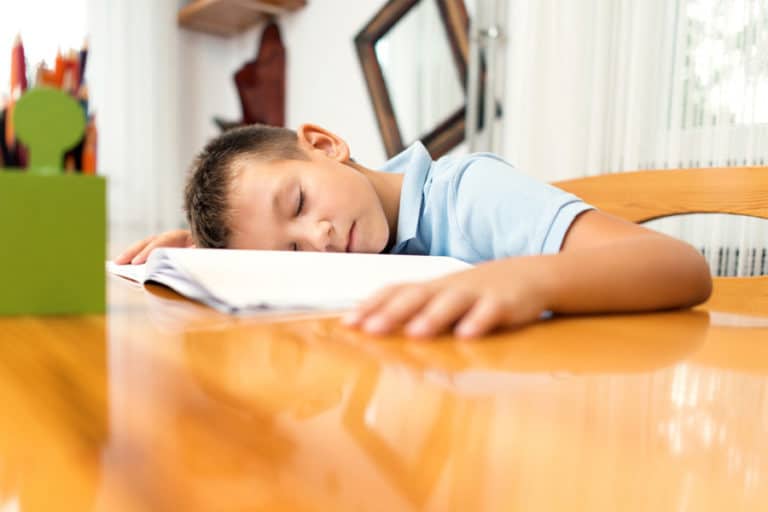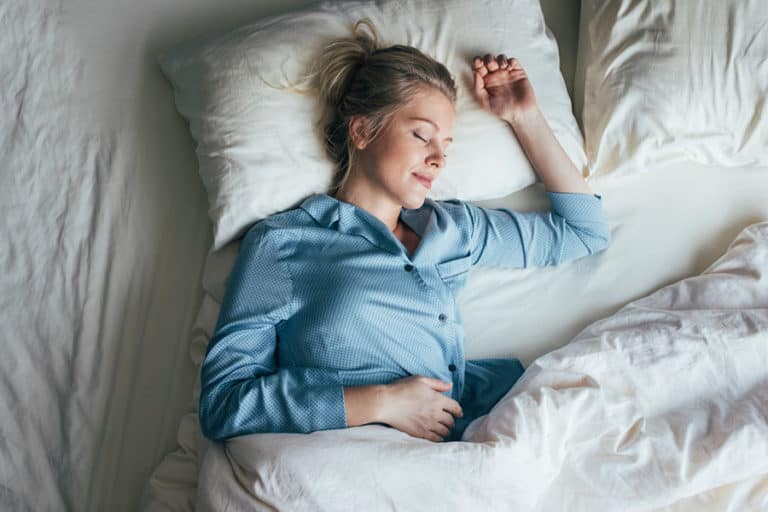5 Best Sleep Positions for Back Pain Relief

Are you struggling with finding the correct sleep positions for back pain relief? Well, here are some proven methods to help you have pain-free and sound sleep.
One of the keys to having a productive day is getting a good night’s rest. You’d agree that being able to sleep without discomfort is crucial to your well-being and health. But many suffer from back pains and are robbed of the gift of sound sleep.
Studies [1]American Academy of Sleep Medicine: The good life: Good sleepers have better quality of life and less depression have shown that Americans who sleep for longer hours are more alert than those who slept for shorter periods. Other findings [2]Berkeley News: Sleep loss heightens pain sensitivity, dulls brain’s painkilling response have also shown that not getting enough sleep can lead to an increase in pain sensitivity.
Luckily, there are sleep positions that can help to alleviate back pain. By identifying back pain causes and employing a few sleep hygiene tips, you can get the correct posture for your back and sleep better than you have ever done before. With some healthy sleeping ideas, you can get back to living a healthier and more productive life.
Importance Of Good Posture For Back Pain Prevention
One of the essentials for good health is having a good posture. Generally, posture refers to the body’s positioning when sitting, standing, or lying down.
A good posture entails having a proper body alignment when sitting or standing. Your posture is crucial to the prevention of back pain because it helps your body to:
- Reduce stress on your lower back
- Relieve pressure on the structures of your spine
- Support your spine so that your weight doesn’t strain your spine
All this automatically has a positive impact on other parts of the body as well. For example, the lower abdomen region is much more relaxed and therefore suffers from fewer aches, pains, digestive troubles, and so on.
Proper spinal alignment also means a relaxed pulmonary region. This in turn opens up the lungs and relieves pressure on the heart. With a better spinal alignment during waking hours and sleep, you can expect to suffer lesser neck pain, shoulder pain, and upper and lower back pain.
Best Sleep Positions For Back Pain
Getting the best out of your shut-eye period depends significantly on the position you sleep in. And if you are suffering from back pain, here are a few tips to help you get back on track:
1. In a reclined position, sleep on your back
Lying flat in the reclining position is probably the best sleeping position for your body because it helps your back maintain its natural curve (unless you are using a mattress that is too soft). It creates an angle between your trunk and thighs. The angle formed helps fix conditions [3]National Library of Medicine: Spondylolisthesis such as the isthmic spondylolisthesis by reducing the pressure on the spine.
2. Sleeping on your side while having a pillow between your knees
Another way to help you cope better with lower back pain is by sleeping on your side with one pillow between your knees. Start by sleeping with your left or right shoulder and the whole of your body on the mattress.
The addition of a thin pillow or a slim rolled towel between your knees helps in improving your alignment as it enables you to keep your pelvis, spine, and hips in a straight line. You could also consider adding a small pillow if there is a gap between your waist and the mattress for added support.
3. In the fetal position, sleep on your side
Sleeping in the fetal position is a sure bet to getting a night of better sleep quality for those with a herniated disc or degenerative disc disease. You can start by laying on your back, then gently roll over to your side.
This is followed by tucking your knees towards your chest region while you slowly curl your torso towards your knees. Between the vertebrae in your spine, you have your discs serving as soft cushions.
Sleeping in this position helps relieve or reduce the effect of herniation. Often, it is characterized by a part of a disc pushing out of its natural space, usually accompanied by weakness, nerve pain, and many other conditions. This position can relieve lower back pain. Therefore, this could be the best sleeping position for you.
4. Sleep face down on your stomach with a pillow under your abdomen
Sleeping on your stomach may not seem like a good option for relieving back pain because of its effect on your neck. However, some of us are natural stomach sleepers and find this stomach sleeping position more comfortable and relaxing than any other sleeping position.
So what you do whenever you choose to sleep face down on your stomach is you start with your head slightly elevated, then you could place a pillow underneath your abdomen. This will help reduce some of the pressure off your back, allowing you to sleep better.
You may also choose not to elevate your head with a pillow if you find this as a comfortable sleeping position. Avoid sleeping in this position if you do not feel comfortable.
5. Lay flat on your back, having a pillow under your knees
Seen as one of the best ways to relieve back pain, sleeping on your back is the most natural sleep position. Although it may be challenging to remain in this position, it can be more convenient if you add a pillow under your knees.
This will help keep your spine neutral with your weight evenly distributed and spread adequately across all body areas. The addition of the pillow is also essential as it works solely to maintain the curve in your lower back.
Other Ways To Relieve Back Pain While Sleeping
There are chances that you may have difficulty maintaining the positions mentioned earlier. Nevertheless, you can imbibe one or two principles to find the best sleeping positions that can help you sleep better.
Here are some helpful tips to find your best sleeping positions and ensure that your body isn’t negatively affected by those sleep angles:
Maintain a proper alignment
The key to fixing your back pain is proper spinal alignment. Regardless of the position you choose to sleep in, maintaining a proper and natural alignment of your spine could be considered the most crucial ingredient for a good night’s rest.
While twisting and turning on the bed, the chances are that you get out of alignment. So, keep in mind the recommended sleeping positions and be careful not to sleep with spaces between your body and the mattress to avoid bad posture sleeping.
Get a pillow that works for you
Putting a pillow in the proper position while sleeping could also help you fix your back pain. Depending on how you prefer your sleeping position to be, several types of pillows are available.
If you sleep on your back, you may want to choose a thinner pillow with extra paddings to support your neck. Examples include the memory foam, which molds around the shape of your neck, and the water pillow, which gives comprehensive support.
Moreover, if you sleep on your stomach, you should use the thinnest pillow possible or none at all. You could also try holding a body pillow while sleeping on your side.
Then, if you are a side sleeper, you should get a firm pillow or, better still, one with an extra-wide gusset that can help with the spaces between your shoulder and your ear. Do not forget to change your pillow every 18 months or thereabout.
Carefully get into and out of bed
When getting in or out of bed, do your best to avoid making any jerking motions that could aggravate your condition. Instead, be extra careful, take your time to roll your body to a side, and lift yourself gently with your hands.
Follow up by swinging your legs out of bed and slowly standing up. You can repeat this movement in a reversed mode when trying to get into bed.
Get a better mattress
Sleeping better could be as simple as getting a suitable mattress. According to the recommendation [4]Sleep Foundation: When Should You Replace Your Mattress? by the national sleep foundation, your mattress should be evaluated every 6 to 8 years.
It was discovered in a study that up to 63% of people experienced significant improvements in their chronic low back pain after switching to a new mattress. Depending on your budget and your body type, you should get a new mattress.
Mattress comes in different types, densities, and widths. Test the several available options in the market and choose what aligns with your body.
You could also try sleeping on different mattresses before you settle for a choice. Remember to follow the feeling each type gives you, and if necessary, you could try putting the mattress on the floor.
A word of caution is to avoid buying a soft mattress. Any sort of spring or soft mattresses can deteriorate your spinal alignment and could interfere with your sleep cycle. It is because when you sleep on a soft mattress, the pelvic area of your body sags in due to your body weight and deteriorates your spinal alignment. Thus, it can become the reason behind your sleep deprivation.
Try yoga stretches
Gentle yoga stretches can also help improve your sleeping experience. Research has shown that yoga, with its many stretching motions, can help reduce stress and your low back pain allowing you to sleep better and fall asleep quickly.
Get acquainted with a yoga instructor, attend a few classes and figure out what works. While at it, you can also get yoga props like bolsters and blocks for additional support to comfortably hold poses.
Exercise your core and find the position that works for you
Generally, exercising has benefits beyond having a good night’s sleep. But for this discourse, targeted exercises that strengthen the core help the muscles of the abdomen, lower back, hips, and pelvis, ultimately easing your back pain in bed.
Training your abdominal muscles helps you build strength and flexibility so that the chances of straining the muscles of your back are considerably lowered. One of the exercises you could try out is a plank.
Start by holding your body in a plank position for at least 30 seconds, then work your way up as your endurance increases.
Conclusion
Finding good sleep hygiene tips that would work for you depends on your favored sleeping positions and your daily lifestyle. Moreover, an extra tip would be to try subtle exercises to relieve the pain in your back.
Using the detailed sleeping positions and suggestions mentioned in this article, you will stand a greater chance of maximizing your sleeping period and sleep quality for a more fulfilling and healthy living.
References
| ↑1 | American Academy of Sleep Medicine: The good life: Good sleepers have better quality of life and less depression |
|---|---|
| ↑2 | Berkeley News: Sleep loss heightens pain sensitivity, dulls brain’s painkilling response |
| ↑3 | National Library of Medicine: Spondylolisthesis |
| ↑4 | Sleep Foundation: When Should You Replace Your Mattress? |





